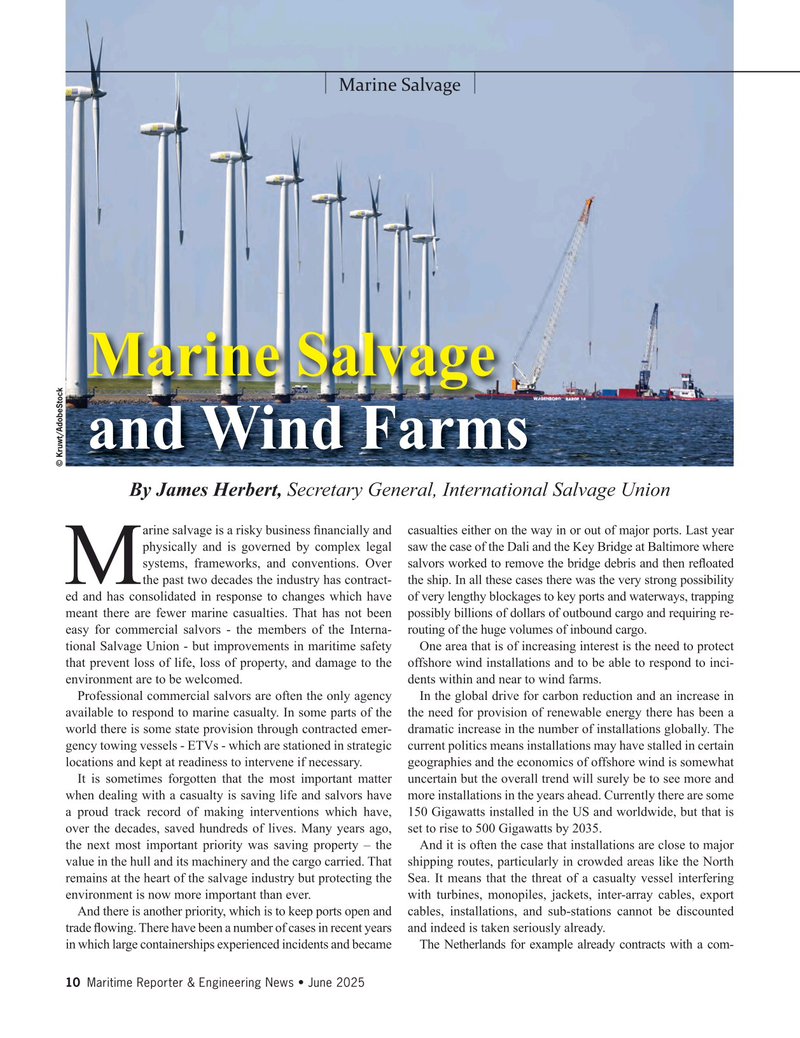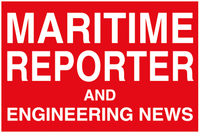
Page 10: of Maritime Reporter Magazine (June 2025)
Read this page in Pdf, Flash or Html5 edition of June 2025 Maritime Reporter Magazine
Marine Salvage
Marine Salvage and Wind Farms © Kruwt/AdobeStock
By James Herbert, Secretary General, International Salvage Union arine salvage is a risky business ? nancially and casualties either on the way in or out of major ports. Last year physically and is governed by complex legal saw the case of the Dali and the Key Bridge at Baltimore where systems, frameworks, and conventions. Over salvors worked to remove the bridge debris and then re? oated
Mthe past two decades the industry has contract- the ship. In all these cases there was the very strong possibility ed and has consolidated in response to changes which have of very lengthy blockages to key ports and waterways, trapping meant there are fewer marine casualties. That has not been possibly billions of dollars of outbound cargo and requiring re- easy for commercial salvors - the members of the Interna- routing of the huge volumes of inbound cargo.
tional Salvage Union - but improvements in maritime safety One area that is of increasing interest is the need to protect that prevent loss of life, loss of property, and damage to the offshore wind installations and to be able to respond to inci- environment are to be welcomed. dents within and near to wind farms.
Professional commercial salvors are often the only agency In the global drive for carbon reduction and an increase in available to respond to marine casualty. In some parts of the the need for provision of renewable energy there has been a world there is some state provision through contracted emer- dramatic increase in the number of installations globally. The gency towing vessels - ETVs - which are stationed in strategic current politics means installations may have stalled in certain locations and kept at readiness to intervene if necessary. geographies and the economics of offshore wind is somewhat
It is sometimes forgotten that the most important matter uncertain but the overall trend will surely be to see more and when dealing with a casualty is saving life and salvors have more installations in the years ahead. Currently there are some a proud track record of making interventions which have, 150 Gigawatts installed in the US and worldwide, but that is over the decades, saved hundreds of lives. Many years ago, set to rise to 500 Gigawatts by 2035.
the next most important priority was saving property – the And it is often the case that installations are close to major value in the hull and its machinery and the cargo carried. That shipping routes, particularly in crowded areas like the North remains at the heart of the salvage industry but protecting the Sea. It means that the threat of a casualty vessel interfering environment is now more important than ever. with turbines, monopiles, jackets, inter-array cables, export
And there is another priority, which is to keep ports open and cables, installations, and sub-stations cannot be discounted trade ? owing. There have been a number of cases in recent years and indeed is taken seriously already. in which large containerships experienced incidents and became The Netherlands for example already contracts with a com- 10 Maritime Reporter & Engineering News • June 2025
MR #6 (1-17).indd 10 MR #6 (1-17).indd 10 5/31/2025 8:29:53 PM5/31/2025 8:29:53 PM

 9
9

 11
11
